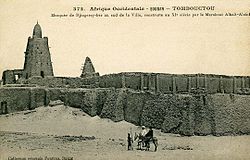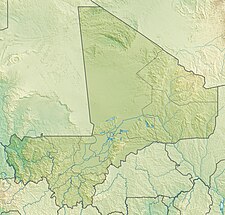The Djinguereber Mosque (Arabic: مسجد دجينجيربر; French: Mosquée de Djinguereber; from Koyra Chiini jiŋgar-ey beer 'grand mosque'[1]), also known as Djingareyber or Djingarey Ber, is a famous learning center in Timbuktu, Mali. Built in 1327, it is one of three madrassas composing the University of Timbuktu. It was inscribed on the list of UNESCO World Heritage Sites in 1988.[2]
| Djinguereber Mosque | |
|---|---|
مسجد جينجيربر Mosquée de Djinguereber | |
 | |
| Religion | |
| Affiliation | Islam |
| Branch/tradition | Sunni |
| Location | |
| Location | Timbuktu, Mali |
| Geographic coordinates | 16°46′17″N 3°0′36″W / 16.77139°N 3.01000°W |
| Architecture | |
| Type | mosque |
| Completed | 1327 |


Design
editThe design and construction of the Djinguereber mosque is traditionally credited to the Andalusi scholar Abu Ishaq Al Sahili. According to Ibn Khaldun - one of the best-known sources on 14th-century Mali - he was said to have received 12,000 mithkals of gold dust for the work. More recent analyses reject this version, demonstrating that the architectural style of the Djinguereber Mosque and others in West Africa derives mainly from mosques in the Sahara and traditional African architecture and religions, so that al-Sahili's influence on West African architecture is treated as a myth.[3][4]
Except for a small part of the northern facade, which was reinforced in the 1960s in alhore (limestone blocks, also widely used in the rest of the town), and the minaret, also built in limestone and rendered with mud,[5] the Djingareyber Mosque is made entirely of earth plus organic materials such as fibre, straw and wood. It has three inner courts, two minarets and twenty-five rows of pillars aligned in an east-west direction and a prayer space for 2,000 people.
History
editFoundation of the mosque
editAround 1325 the creation of the mosque is attributed to Mansa Musa who paid 200kg of gold to build the mosque.
Medieval Period
editDuring the reign of Askia Dawud of the Songhai Empire, Djinguereber mosque was renovated by the Qadi of Timbuktu Aqib ibn Mahmud beginning in 1570. The work was a source of conflict between the Askia and the Qadi, who resented the renovated mosque's association with a secular power.[6]
Post-Independence
editOn 26 February 2010, during Mawlid (a festival to mark the birth anniversary of Muhammad), a stampede at the mosque killed around 26 people and injured at least 55 others, mostly women and children.[7]
Attack in 2012
editOn 1 July 2012, militant Islamists of the Ansar Dine ("defenders of faith") began destroying the tombs of Timbuktu shortly after UNESCO placed them on a list of endangered World Heritage sites. They set about destroying seven of Timbuktu's total sixteen ancient Muslim saint shrines,[8] including two tombs at the Djingareyber Mosque.[8] Using "hoes, pick-axes and chisels, they hammered away at the two earthen tombs until they were completely destroyed".[8] The damage to the mosque itself, however, was minimal.[9]
Preservation Efforts
editThe mosque was on the UN's list of World Heritage Sites in danger in 1990 due to sand encroachment from increasing desertification.[10] A four-year project towards the restoration and rehabilitation of the Mosque began in June 2006, and is being conducted and financed by the Aga Khan Trust for Culture.[11]
The first phase of restoration was a pilot project undertaken from November 2006 to July 2007. This work included drainage and paving around the mosque, re-rendering walls in bad condition and in one zone of the roof, replacing around 50% of the beams, above which was a heavy build-up of mud plaster. The local masons in charge of the project clearly had good technical expertise; however, there is a need to regularly document their activities and starting point.[12] Natural local trees that were originally used for building materials for the beams in the mosque have also disappeared due to climate change, so wood beams must be imported from Ghana. This drastically increases the price of resources needed to restore the mosque, as building materials aren't readily available anymore.[13] Despite ongoing maintenance efforts, there is still a one-meter difference between the roof height in 1952 and today.[citation needed]
While drought may cause issues, too much rain has also shown to be detrimental to the mosque. Heavy rains in 1999, 2001, and 2003 caused the collapse of many traditionally built earthen buildings, as well as more recently built structures. Climate change is expected to increase the severity of these threats.[14]
Aftering being de-listed in 2005, the Djinguereber has once again been on the list of World Heritage Sites in danger since the attack by Ansar Dine in 2012.[15]
3D Model with Laser-Scanning
editThe Zamani Project documents cultural heritage sites in 3D to create a record for future generations.[16][17][18] The documentation of the Djinguereber Mosque is based on terrestrial laser-scanning.[19][20][21] The 3D documentation of the Djinguereber Mosque was carried out in 2005.[22] A 3D model, plans and images can be viewed here.
See also
editReferences
edit- ^ Heath, Jeffrey (1998). Koyra Chiini. (Dictionnaire songhay-anglais-français, I.). Paris: L'Harmattan. p. 146. ISBN 2-7384-6726-1.
- ^ Report of the World Heritage Committee, Twelfth Session, Brasilia: UNESCO Convention Concerning the Protection of World Cultural and Natural Heritage, 23 December 1988, pp. 17–18, SC-88/CONF.001/13, retrieved 9 April 2007
- ^ The Meanings of Timbuktu, Bloom, Pg. 52.
- ^ Aradeon, Susan B. (1989). "Al-Sahili: the historians' myth of architectural technology transfer from North Africa". Journal des africanistes. 59 (1–2): 99–131. doi:10.3406/jafr.1989.2279.
- ^ "Djingereyber Mosque Restoration". Archnet.org.
- ^ Gomez, Michael (2018). African dominion : a new history of empire in early and medieval West Africa. Princeton, NJ: Princeton University Press. p. 352. ISBN 9780691177427.
- ^ Deadly crush at Timbuktu mosque, BBC News, 26 February 2010, retrieved 14 June 2010; Pilgrims killed in stampede at Djingareyber Mosque in Timbuktu, UNESCO World Heritage News Archive, 26 February 2010, retrieved 14 June 2010; 26 dead in Timbuktu mosque stampede, Reuters, 26 February 2010, retrieved 14 June 2010; Wikinews
- ^ a b c Mali Islamists destroy tombs at ancient Timbuktu mosque | Radio Netherlands Worldwide Archived 29 October 2013 at the Wayback Machine
- ^ "Timbuktu's Djinguereber mosque: a history of cities in 50 buildings, day 5". The Guardian. 27 March 2015. Retrieved 11 September 2015.
- ^ Report of the World Heritage Committee, Fourteenth Session, Banff: UNESCO Convention Concerning the Protection of World Cultural and Natural Heritage, 12 December 1990, pp. 17–18, CLT-90/CONF.004/13, retrieved 9 April 2007
- ^ "La Cité des 333 saints abrite de nombreux chantiers de modernisation" (in French). Afribone Mali SA. 5 April 2007. Retrieved 9 April 2007.
- ^ UNESCO World Heritage Centre. "UNESCO World Heritage Centre - State of Conservation (SOC 2008) Timbuktu (Mali)". whc.unesco.org. Retrieved 8 October 2018.
- ^ Smith, Alex Duval (27 March 2015). "Timbuktu's Djinguereber mosque: a history of cities in 50 buildings, day 5". the Guardian. Retrieved 8 October 2018.
- ^ Colette, Augustin, and Kishore Rao. Case Studies on Climate Change and World Heritage. UNESCO World Heritage Centre, 2009, pp. 74–75, Case Studies on Climate Change and World Heritage.
- ^ UNESCO World Heritage Centre. "State of Conservation Timbuktu (2023)". whc.unesco.org. Retrieved 5 May 2024.
- ^ Rüther, Heinz; Rajan, Rahim S. (2007). "Documenting African Sites: The Aluka Project". Journal of the Society of Architectural Historians. 66 (4): 437–443. doi:10.1525/jsah.2007.66.4.437. ISSN 0037-9808. JSTOR 10.1525/jsah.2007.66.4.437.
- ^ Giles, Chris (5 January 2018). "Meet the scientists immortalizing African heritage in virtual reality". CNN. Retrieved 17 October 2019.
- ^ Wild, Sarah (18 December 2018). "Africa's great heritage sites are being mapped out with point precision lasers". Quartz Africa. Retrieved 17 October 2019.
- ^ Rüther, Heinz. "AN AFRICAN HERITAGE DATABASE – THE VIRTUAL PRESERVATION OF AFRICA'S PAST" (PDF). isprs.org. Archived (PDF) from the original on 15 February 2017.
- ^ Rüther, Heinz; Held, Christof; Bhurtha, Roshan; Schroeder, Ralph; Wessels, Stephen (13 January 2012). "From Point Cloud to Textured Model, the Zamani Laser Scanning Pipeline in Heritage Documentation". South African Journal of Geomatics. 1 (1): 44–59–59. ISSN 2225-8531.
- ^ "Challenges in Heritage Documentation with Terrestrial Laser Scanning" (PDF). Archived (PDF) from the original on 25 September 2019.
- ^ "Site - Timbuktu Mosque". zamaniproject.org. Retrieved 30 October 2019.
- Translated from Ibn Khaldun, loc. cit., p. 348.
